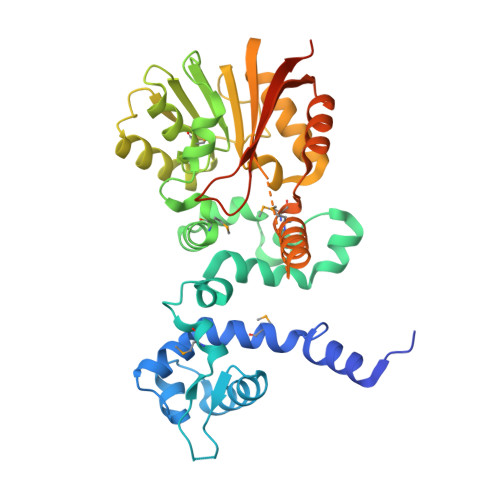Aclacinomycin 10-Hydroxylase Is a Novel Substrate-assisted Hydroxylase Requiring S-Adenosyl-L-methionine as Cofactor
Jansson, A., Koskiniemi, H., Erola, A., Wang, J., Schneider, G., Niemi, J.(2005) J Biol Chem 280: 3636-3644
- PubMed: 15548527
- DOI: https://doi.org/10.1074/jbc.M412095200
- Primary Citation of Related Structures:
1XDS, 1XDU - PubMed Abstract:
Aclacinomycin 10-hydroxylase is a methyltransferase homologue that catalyzes a S-adenosyl-L-methionine (AdoMet)-dependent hydroxylation of the C-10 carbon atom of 15-demethoxy-epsilon-rhodomycin, a step in the biosynthesis of the polyketide antibiotic beta-rhodomycin. S-Adenosyl-L-homocysteine is an inhibitor of the enzyme, whereas the AdoMet analogue sinefungin can act as cofactor, indicating that a positive charge is required for catalysis. 18O2 experiments show that the hydroxyl group is derived from molecular oxygen. The reaction further requires thiol reagents such as glutathione or dithiothreitol. Incubation of the enzyme with substrate in the absence of reductant leads to the accumulation of an intermediate with a molecular mass consistent with a perhydroxy compound. This intermediate is turned into product upon addition of glutathione. The crystal structure of an abortive enzyme-AdoMet product ternary complex reveals large conformational changes consisting of a domain rotation leading to active site closure upon binding of the anthracycline ligand. The data suggest a mechanism where decarboxylation of the substrate results in the formation of a carbanion intermediate, which is stabilized by resonance through the aromatic ring system of the anthracycline substrate. The delocalization of the electrons is facilitated by the positive charge of the cofactor AdoMet. The activation of oxygen and formation of a hydroxyperoxide intermediate occurs in a manner similar to that observed in flavoenzymes. Aclacinomycin-10-hydroxylase is the first example of a AdoMet-dependent hydroxylation reaction, a novel function for this cofactor. The enzyme lacks methyltransferase activity due to the positioning of the AdoMet methyl group unfavorable for a SN2-type methyl transfer to the substrate.
Organizational Affiliation:
Department of Medical Biochemistry and Biophysics, Karolinska Institutet, S-171 77 Stockholm, Sweden.

















